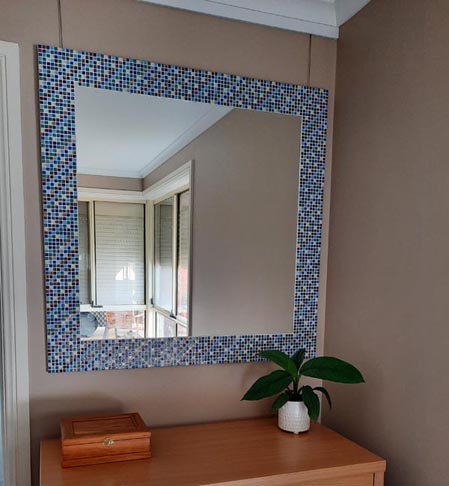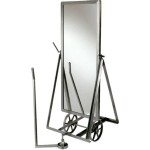How to Hang a Large Heavy Mirror On the Wall
Hanging a large, heavy mirror presents a unique set of challenges compared to hanging lighter wall decor. The weight involved necessitates careful planning, the use of appropriate hardware, and a thorough understanding of wall structures to ensure the mirror is securely mounted and poses no risk of falling. This article provides a detailed guide on how to safely and effectively hang a large, heavy mirror on a wall.
Assessing the Mirror and Wall
Before even considering the actual hanging process, a comprehensive assessment of both the mirror and the wall is crucial. This step ensures the chosen hanging method is suitable for the specific situation.
First, the weight of the mirror itself must be determined. This information is usually available on the mirror's packaging or from the manufacturer. If the weight is unknown, using a bathroom scale is a viable alternative. Precise weight knowledge is fundamental for selecting the correct type and quantity of mounting hardware.
Next, the mirror's hanging hardware should be examined. Many mirrors come pre-equipped with D-rings, wire, or keyhole slots. While these may seem adequate, they are often insufficient for heavier mirrors, especially those exceeding 50 pounds. Consider replacing these with more robust hardware if necessary. The position of the hanging hardware on the mirror will also influence the placement of the mounting points on the wall.
The type of wall is arguably the most critical factor. Common wall types include drywall, plaster, and concrete, each requiring different anchoring methods. Drywall, being the most common, is also the least structurally sound. Mounting directly to drywall without proper anchors will almost certainly result in failure. Plaster walls, while slightly stronger, still require specialized anchors due to their brittle nature. Concrete walls, on the other hand, offer the most robust support but necessitate the use of masonry drills and concrete anchors.
To determine the wall type, a small, inconspicuous area can be tested. Gently drilling a small pilot hole will reveal the material. Drywall will produce a fine, powdery dust, while plaster will yield larger, more granular fragments. Concrete will require significantly more force to drill through and will produce a coarse, rocky dust.
Finally, locating wall studs is paramount, especially when dealing with drywall or plaster walls. Studs are vertical wooden or metal beams that provide structural support. Hanging the mirror directly onto a stud provides significantly more stability than relying solely on anchors in the drywall or plaster. A stud finder is an essential tool for this task. Electronic stud finders utilize sensors to detect changes in density within the wall, while magnetic stud finders detect the presence of nails or screws used to attach the drywall to the studs. It is advisable to verify the stud's location by hammering a small nail into the wall. If the nail hits solid wood, a stud has been located.
Selecting Appropriate Hardware and Tools
Once the mirror's weight and the wall type are determined, selecting the appropriate hardware and tools becomes a straightforward process. Incorrect hardware selection is a leading cause of mirror-hanging failures, so careful consideration is vital.
For drywall walls, several anchor options exist. Toggle bolts are among the strongest, functioning by inserting a spring-loaded wing through a pre-drilled hole. Once inside the wall, the wings expand, providing a secure grip. Heavy-duty drywall anchors, often made of metal or reinforced plastic, are another viable option. These anchors typically feature self-drilling tips and expanding mechanisms to grip the drywall. The weight rating of the chosen anchors must significantly exceed the weight of the mirror, erring on the side of caution.
For plaster walls, using plaster screws or specialized plaster anchors is recommended. Plaster screws are designed to grip the brittle plaster without cracking it. Plaster anchors, similar in function to drywall anchors, provide a more secure hold by distributing the weight over a larger area. Pre-drilling pilot holes is crucial to prevent cracking the plaster.
For concrete walls, concrete anchors are mandatory. These anchors are designed to expand within the drilled hole, creating a strong bond with the concrete. Wedge anchors, sleeve anchors, and tapcon screws are common types of concrete anchors. The selection depends on the mirror's weight and the specific requirements of the hanging hardware. A hammer drill is essential for drilling into concrete.
If a stud is located, using screws long enough to penetrate at least 1.5 inches into the stud is the preferred method. This provides a significantly stronger hold compared to using anchors. Wood screws are suitable for wooden studs, while self-tapping metal screws are appropriate for metal studs.
In addition to anchors and screws, other essential tools include a level, a measuring tape, a pencil, a drill with appropriate drill bits, a screwdriver, and safety glasses. A stud finder, as previously mentioned, is crucial for locating wall studs. A helper is also highly recommended, especially for larger and heavier mirrors.
The Hanging Process: A Step-by-Step Guide
With the assessment complete and the hardware and tools assembled, the actual hanging process can begin. Accuracy and attention to detail are paramount to ensuring a successful and safe installation.
The first step is to accurately measure and mark the desired location of the mirror on the wall. Use a measuring tape and a level to ensure the mirror is positioned correctly and horizontally aligned. Lightly mark the top edge of the mirror with a pencil.
Next, determine the placement of the mounting points. This depends on the type of hanging hardware on the back of the mirror. Measure the distance from the top edge of the mirror to the hanging hardware. Transfer this measurement to the wall, marking the exact location for the anchor or screw placement. If the mirror has multiple hanging points, ensure they are evenly spaced and level.
If hanging on drywall or plaster and a stud has been located, pre-drill a pilot hole through the wall and into the stud. Use a drill bit slightly smaller than the diameter of the screw being used. This prevents the wood from splitting and makes it easier to drive the screw in. Insert the screw through the mirror's hanging hardware and into the pilot hole, tightening it until the mirror is securely mounted.
If hanging on drywall or plaster without a stud, pre-drill holes for the chosen anchors at the marked locations. The diameter of the drill bit should match the specifications of the anchors. Insert the anchors into the holes, following the manufacturer's instructions. This may involve tapping them in with a hammer or using a special tool to expand them. Once the anchors are securely in place, insert the screws through the mirror's hanging hardware and into the anchors, tightening them until the mirror is securely mounted.
If hanging on concrete, use a hammer drill with a masonry bit to drill holes at the marked locations. The diameter of the drill bit should match the specifications of the concrete anchors. Insert the anchors into the holes, following the manufacturer's instructions. This typically involves hammering them in and then tightening them to expand them within the hole. Insert the screws through the mirror's hanging hardware and into the anchors, tightening them until the mirror is securely mounted.
Once the mirror is mounted, use a level to verify that it is hanging straight. Make any necessary adjustments by slightly loosening or tightening the screws. It is essential to have a helper support the mirror during this process to prevent it from falling.
Finally, perform a weight test by gently pushing on the mirror. This will help ensure that the mounting hardware is secure and that the mirror is not at risk of falling. The weight test should be conducted carefully and gradually. If any movement or instability is detected, immediately remove the mirror and re-evaluate the hanging method.

How To Hang A Large Or Heavy Mirror

A Better Way To Hang Heavy Mirror Hanging Brackets
How To Hang A 100 Pound Mirror On Drywall Quora

How To Hang A Heavy Mirror C R F T

How To Hang A Heavy Mirror The Home Depot

How To Hang A Large Wall Mirror Step By Tutorial

How To Hang A Very Heavy Picture Or Mirror The Best

How To Hang A Heavy Mirror

How To Hang A Heavy Mirror With Pictures Wikihow

How To Hang A Heavy Mirror In 5 Simple Steps








